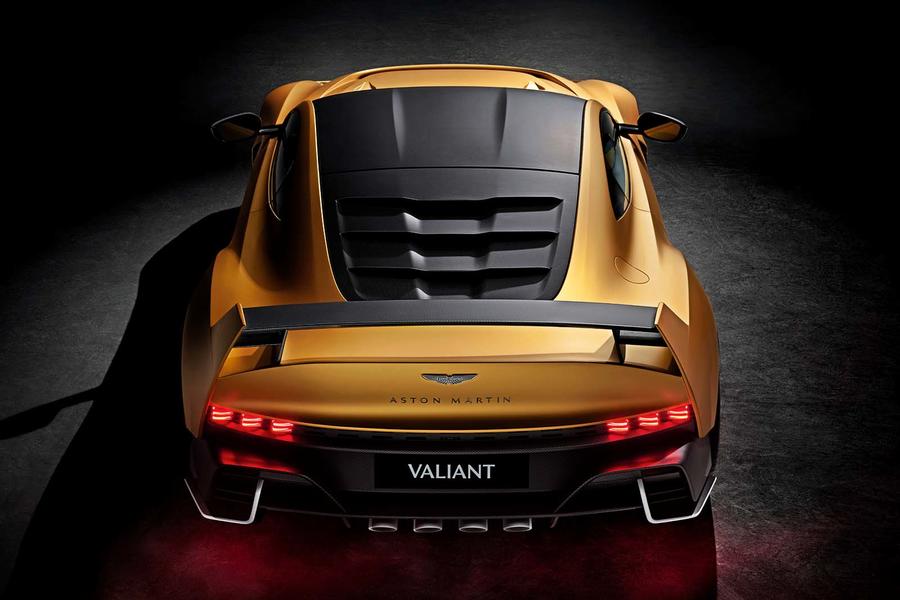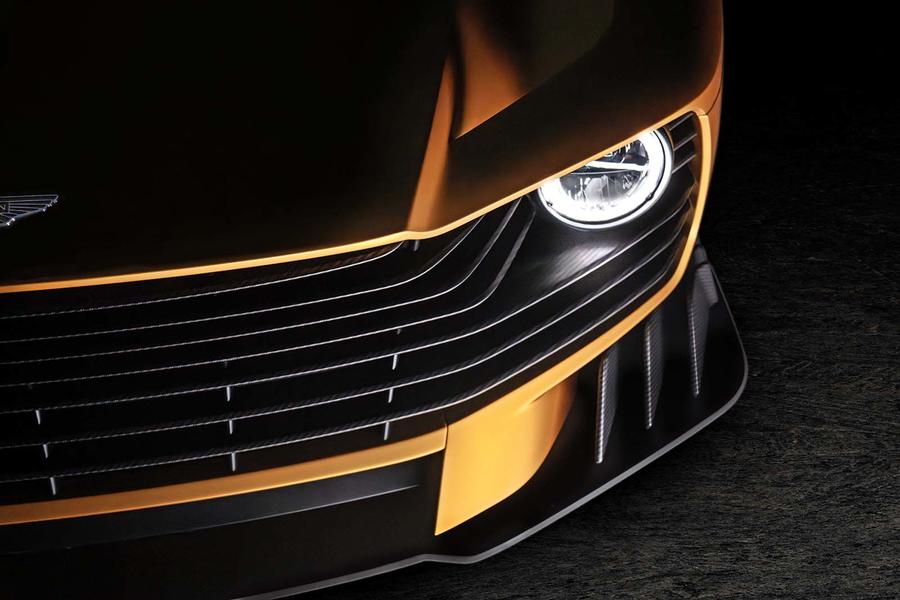News
Aston Martin Valiant: Manual Track Weapon with V12 Engine

Valour-based Valiant has a 734bhp V12 and carbonfibre bodyworkSupercar is bespoke commission from two-time world champion Fernando Alonso; just 38 will be produced
The new Aston Martin Valiant is a limited-run track-focused reworking of the exclusive Valour built to a brief from Formula 1 ace Fernando Alonso.
The new road-legal special edition draws its power from a 734bhp 5.2-litre twin-turbo V12 and is set to make its public debut at the Goodwood Festival of Speed next month.
Just 38 examples will be produced by the Q by Aston Martin division. The Valiant is a development of the limited-run Valour from 2023, which was in turn based on a bespoke body structure derived from the V12 Vantage.
Aston says the new car has been created as a result of a “personal commission” from two-time world champion Alonso, who drives for Aston’s F1 squad.
Alonso said he wanted a “more extreme, race car-inspired version” of the Valour, prompting Aston engineers to focus on adding power and downforce while reducing weight.

The V12 engine offers the same 555lb ft of torque as in the Valour, but the power – delivered through a six-speed manual gearbox – has been boosted by 29bhp. Aston global brand chief Marco Mattiacci said the car has been treated to an “obsessive weight-reduction” programme.
This includes the adoption of a 3D-printed rear subframe claimed to save 3kg with no reduction in stiffness, and a magnesium torque tube that removes 8.6kg of mass from the centre of the car.
The use of a lithium ion battery saves 11.5kg, while the 21in lightweight magnesium wheels (featuring 275/35 front and 325/30 rear tyres) reduce unsprung mass by 14kg.
Although Aston hasn’t disclosed the car’s overall weight figure, the total saving compared with the Valour is around 100kg.
The Valiant’s bodywork has been largely sculpted in carbonfibre and a host of styling changes from the Valour add downforce while reducing drag. There is a large front splitter, which features F1-esque multi-layer end plates to smooth airflow past the front wheels.

The carbonfibre grille is claimed to increase the flow of air to the engine and the wings are heavily sculpted. Aero discs are mounted on the wheels to reduce turbulence, with six inlets positioned to draw cooling air onto the carbon-ceramic brakes.
There are also apertures around the wheel to allow the heat generated by the brakes to dissipate. The rear features a Kamm tail design with a raised deck lid, topped by a large fixed wing.
Underneath sits a large rear diffuser honed using computational fluid dynamics, with four titanium exhaust pipes mounted within.
The interior of the two-seater has a focus on motorsport-esque functionality, with large swathes of exposed carbonfibre.
A new, circular steering wheel features a slimmer frame and has been stripped of all switches for a more intuitive feel. The gear selector is also a new design and a large cutaway in the transmission tunnel shows off the gear linkage. To fit its track-focused brief, the Valiant gains a built-in steel half-cage and Recaro Podium race seats that can be fitted with four-point race harnesses.
There is a choice of Alcantara or semi-aniline leather trim and the door panels feature mesh inserts and fabric door release pulls. Aston has not disclosed pricing for the 38 Valiants that will be sold, but it is understood that each will cost close to £2 million and feature high levels of customisation.
Mercedes-AMG Recall Due to Leaky Wiring | Giga Gears

Luca de Meo Wins Issigonis Trophy at Autocar Awards 2024
 Industry leaders and best new models recognised in Autocar Awards 2024 - see the full list below
Industry leaders and best new models recognised in Autocar Awards 2024 - see the full list below
Renault Group CEO Luca de Meo has been given Autocar’s most prestigious award, the Issigonis Trophy, in recognition of his efforts in the astounding turnaround of the firm’s fortunes.
The trophy, named after Mini inventor Sir Alec Issigonis, is awarded to individuals who have made a historically significant contribution to one of the world’s largest industries.
Luca de Meo has become a linchpin of the company which is now producing record profits, less than three years after sustaining ruinous losses running to €140 million a day.
Autocar has also recognised the innovation and achievement of Marek Reichman, Aston Martin’s design chief, with the Sturmey Award, given to resourceful, high-achieving, self-made innovators. During Reichman’s 19 years at the company Aston Martin has flourished into the front-running brand it is today.
The Editor’s Award went to Formula 1 racer turned pundit Martin Brudle. This accolade is given to an individual who has had the greatest success individually or for their company, and the world-leading standards Brundle sets in making F1 accessible to a wider audience is why he is this year’s recipient.
The Mundy Award for Engineering went to David Moss, Nissan’s engineering chief, for his work on developing the groundbreaking Nissan Qashqai.
VW’s design boss Andreas Mindt took home our Design Hero award for sparking fresh life into one the largest and oldest car marques.
Stefanie Wurst won our Outstanding Leader award. The Mini boss has ushered in a bold new generation of models, revived its brand image and has given the BMW Group’s oldest factory a new electric future.
The winner of Autocar’s Innovation Award for 2024 is the Catesby Tunnel, a 1.7-mile hole through the Northamptonshire countryside that once formed part of the Great Central Railway and has recently been repurposed as a globally unique aerodynamic testing facility.
The Lamborghini Huracán Sterrato achieved top marks when put under the microscope by Autocar’s road testers and received the title of Britain's Best Driver’s Car.
In the end, the Sterrato driving experience resonated with the judges because it is a supercar that worked at any time, on any road, in any weather. It means that this Lamborghini, despite its comparatively low lateral grip, is among the most confidence-inspiring performance cars out there.
The Hyundai Ioniq 5 N took the Best Performance Car Award for being a true gamechanger. For electric cars, for performance cars, but especially for electric performance cars. Anyone worried that an electric future might spell the end of fun on four wheels can rest easy, because the Ioniq 5 N is a car that’s huge fun to drive on road and track and also happens to be electric.
Toyota meanwhile took home our Best Manufacturer award. The Japanese company continues to prove naysayers wrong and build brilliant, interesting and reliable cars, all while being run from the top down by people who understand and love cars and driving.
Other cars recognised at the awards were the BMW 5 Series (Best Hybrid), Cupra Born (Best Electric Car), Kia EV9 (Best Large Car), Renault Clio (Best Small Car), Ford Mustang (Best Dream Car)
People award winners
Issigonis Trophy: Luca de Meo, Renault Group
Sturmey Award: Marek Reichman, Aston Martin
Editor’s Award: Martin Brundle
Mundy Award for Engineering: David Moss, Nissan
Design Hero: Andreas Mindt, Volkswagen
Outstanding Leader: Stefanie Wurst, Mini
Innovation: Catesby Tunnel
Car award winners
Britain’s Best Driver’s Car: Lamborghini Huracan Sterrato
Best Dream Car: Ford Mustang
Best Electric Car: Cupra Born
Best Small Car: Renault Clio
Best Large Car: Kia EV9
Best Saloon: VW ID 7
Best Hybrid: BMW 5 Series
Best Manufacturer: Toyota
Ford Recalls 500K F-150 Trucks for Downshift Issue

“Polestar 2 2025: Increased Range, Options, and Swedish Racing Gold Revealed”
